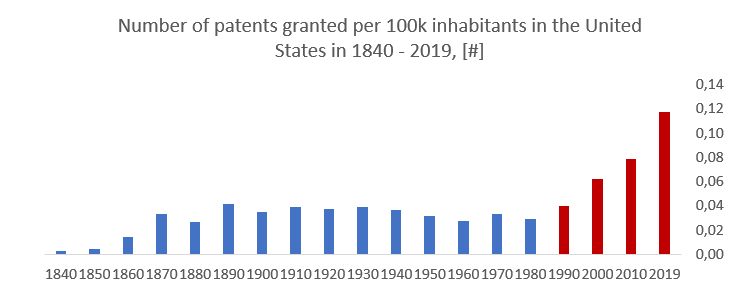The labor market in a nutshell
Adam Smith often referred to as the “father of economics”, believed that specialization of labor was fundamental for economic progress. In 1776 in “Wealth of Nations” he stated that productivity is increased when one worker specializes in one type of activity. As the economists are still debating various theories and new invaluable research is done in the field of labor economy one is inevitably true – since the 1st industrial revolution in the mid-18th century, the number of possible occupations exploded along with the productivity and welfare of the population.
Increased productivity and welfare was undeniably a good thing but it didn’t come without a challenge. With every industrial revolution since the 18th century a challenge of labor adaptation to new inventions came along. This adaptation required employee training and education to make them catch up with the rising need for new skills. This phenomenon which could be as well named “bridging the supply and demand gap of labor” is nowadays becoming most challenging. Before we get into why, let’s take a look at the brief history of these adaptations.
Industrial revolutions and a need for adaptation
The 1st Industrial Revolution impacted mainly the agricultural workforce. Average farmers were predominately performing their tasks by hand, so the introduction of steam machines, textile factories, etc. led to a massive need for new skilled employees like boilermakers, ironsmiths, and steam mechanics, which led to people reskilling from farming to manufacturing. The 2nd revolution at the break of the 19th and 20th century led to the expansion of new industries such as steel, oil, and energy, requiring i.e. steam mechanics to reskill to electricians and a pool of new skills being acquired that previously did not exist.
Finally, the 3rd revolution which brought semiconductors, computing, and Internet, led to electricians reskilling to software and hardware engineers and again a pool of new occupations. The current industrial revolution, named by many as the 4th is marked by emerging technology breakthroughs in a number of fields, including robotics, artificial intelligence, nanotechnology, quantum computing, biotechnology, and is yet again carrying the challenge which is now greater than ever, as the specialization of labor is at its peak.
Faster revolution, less time to adopt
Hence, the pace at which the demand for new occupations (labor specialization) is increasing has never been greater.

Periods between the 1st, 2nd, and 3rd revolutions were a gradual process lasting a whole century, leaving more time for labor to adapt. The period between the 3rd and 4th is twice as short, meaning twice less time to adapt. It becomes even more visible when we look at the patent activity as a benchmark for how fast the innovation has progressed for the last four decades.

Source: the United States Patent and Trademark Office, U.S. Census Bureau
The last four decades, led by advancements in artificial intelligence, robotics, genetic engineering, and others further widen the gap of supply and demand of labor. That is why the adaptation is becoming more challenging than ever. To give a tangible example, reskilling a farmer to operate a steam machine during the 1st industrial revolution and reskilling a steam machine operator to operate an electrical machine during the 2nd industrial revolution was relatively easy and most likely lasted weeks or days. Today, try teaching a seasoned electrician or engineer to become a java developer or try changing a biologist to a genetic engineer specialized in CRISPR. That is why increasing new knowledge and expertise makes the reskilling process harder and troublesome than ever before.
One of the major skills representing the labor market gap is software development. Currently, the estimated supply-demand gap of IT talent is estimated at 10 m globally. In various emerging technologies from robotics to AI and machine learning, besides the technology cost, the main barrier of adoption is the lack of a specialized workforce and know-how. We’re facing an increasing gap of what is possible in the realms of academia and research vs the real world and one of the main causes of it is lack of talent. The problem is persistent and is not going anywhere. There are a couple of solutions to this problem that attack it from different angles.
Solution #1 – Train and deploy more IT talent
As the current IT talent base is limited, various private, as well as public entities, are trying to address the problem by training and deploying a new IT workforce. Companies like Codecool or Pearson are offering paid courses including a polish leader SDA. Public entities like universities or private schools are offering courses and classes as well as 1 on 1 lessons to gradually deploy new talent to the labor market.
Although being the simplest of all solutions and having a constant marginal effect on increasing the supply (every new programmer is bringing so much to the table as the previous one), the process of training takes time and oftentimes the freshly baked developer is not able to satisfy the large portion of demand which a skilled and seasoned developer can.
Solution #2 – Increase productivity of existing IT talent
The market for various tools supporting developers at each stage of the development process from requirements analysis, through design, implementation, testing, and deployment has been booming for the last two decades. Thousands of incumbents are offering various software and tools to make a developer’s work easier, more productive, and more collaborative, hence contributing to increased productivity. This is also supported by developing infrastructure, coding technology, and other trends like cloud computing.
This kind of solution, although crucial and incredibly valuable might have a decreasing marginal effect on productivity – the difference before and after Github in 2008 was more significant in terms of productive collaboration than some of the current solutions offer in 2020. They still make a case and are valuable but in terms of marginal productivity added they are rarely so revolutionary.
Solution #3 – Making talent more flexible and accessible
Finally, there is a third group of companies trying to solve the problem by identifying idle and unused IT talent and utilize it by leveraging their operational excellence, software, and business model. Companies in that space like UpWork or Toptal are solving the talent gap problem by facilitating remote cooperation as well unique access to IT Talent from places where it is unused, like free capacity in software houses. This kind of solution in contrary to solutions #1 and #2 is both easy to implement from day 1 as well as has relatively sustainable marginal effects inefficiencies in the labor market are often.
To sum up, these three types of companies are complementary solvers for the talent gap in the IT sector. Comparing this sector to a plant, #1s (deploying more talent) are additional production lines that need a lot of time and money to be implemented, #2s (increasing talent productivity) are tweaks making everything in a plant work more effectively. Finally, #3s (making talent accessible and flexible) are about managing the plant to ensure that it’s working at 100% capacity. This idea, besides an extraordinary team, combined with the assumption that growing demand for IT talent will continue to surpass supply in the coming years, led us to invest in Talent Alpha, a company aiming to revolutionize the USD 100 bn global IT talent market and change the way companies utilize, measure and manage IT Talent.
How Talent Alpha solves the IT talent gap problem
Talent Alpha is the solution for organizations that know digital talent is mission-critical. It enables business growth and workforce transformation by helping ensure companies have the right people with the right skills in the right place at the right time and cost. Talent Alpha’s talent marketplace offers immediate access to an untapped pool of 20,000+ vetted tech specialists from nearly 400 trusted IT providers – predominantly from Central and Eastern Europe. These specialists aim to be available on-demand for both short and long-term projects. The platform allows for easy search through availability, cost, location, and capabilities of each candidate and provides extraordinary visibility into people’s skills by measuring 3500+ tech skills and psychometrics. As a partner of large enterprises, Talent Alpha serves as a single point of contact and secures the contract as well as service delivery in one agreement. Additionally, Talent Alpha’s solution analyses and maps an individual’s skills, competencies, and personality traits to create a multi-dimensional digital profile of the individual and the whole organization. This unparalleled insight allows informed and immediate strategic workforce decisions to be made with confidence.
If you want to know more about the company visit their website, connect with Przemek (CEO) or contact us.
Visit Talent Alpha: www.talent-alpha.com






